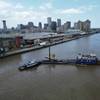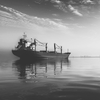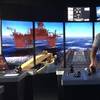Ballast Water Treatment – CAD Survey Aids BWT System installation
Harris Pye successfully tests its 360-degree 3D laser scan for CAD prior to fitting a BWT system in LNG carrier
Maritime and offshore oil & gas engineering company Harris Pye announce that it has successfully used its 360 degree3D scanner to survey the engine room of Neva River (ex Celestine River), an LNG carrier.
The project involved taking a full 3D scan of the engine room in order to ascertain the best system for a ballast water treatment installation. The scan enables Harris Pye engineers to rapidly create three-dimensional images of the entire engine room, and thus create various ballast water treatment models in order to select the best for a client. The entire engine room survey took less than 5 hours, causing minimal disturbance to the crew.
‘The risk mitigation and cost and schedule reductions made possible by using our 3D laser scanner are of huge benefits to our customers – both in the offshore and associated onshore industrial sectors’ says Harris Pye’s Group Technical Director Chris David.
The scan gathers point cloud data which is then processed by Harris Pye’s Naval Architecture team through AutoCAD in order to create multiple walkthrough 3D models from the scans.
‘By being able to create walkthrough 3D models for our clients, we can save them an enormous amount of time and money, because the modelling allows us to test different options with absolute accuracy. It negates all the usual time consuming survey and design work. And when the best solution has been selected, we know with absolutely certainty that the equipment will fit perfectly, down to the last bolt. This is of prime importance on-board vessels, where space is at a premium’, adds Harris Pye’s New Products Technical Manager, Ben Wise.
Harris Pye also uses Inventor Professional isometrics and CADWorx P&ID Professional for process diagram generation. Thermal stress analysis and flow design is done using Caesar II, and Staad pro is used to undertake structural stress analysis. This gives Harris Pye the ability to accurately model pipe and steel work, clash-detect new modelled parts and optimise design.










